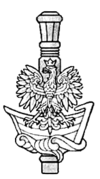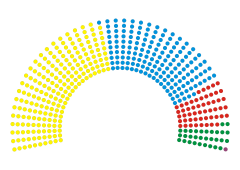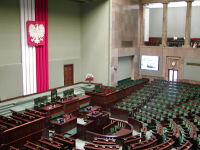Sejm of the Republic of Poland
| Sejm of the Republic of Poland Sejm Rzeczypospolitej Polskiej |
|
|---|---|
 |
|
| Type | |
| Type | Lower house |
| Leadership | |
| Marshal of the Sejm of the Republic of Poland | Grzegorz Schetyna |
| Structure | |
| Members | 460 deputies |
 |
|
| Political groups | PO (209) PiS (166) LiD (53) PSL (31) MN (1) |
| Meeting place | |
 |
|
| The Sejm Building Warsaw | |
| Website | |
| http://www.sejm.gov.pl | |
The Sejm [sɛjm] (![]() listen) is the lower house of the Polish parliament. The Sejm is made up of 460 deputies, or Poseł in Polish. It is elected by universal ballot and is headed by the Marshal of the Sejm (Marszałek Sejmu).
listen) is the lower house of the Polish parliament. The Sejm is made up of 460 deputies, or Poseł in Polish. It is elected by universal ballot and is headed by the Marshal of the Sejm (Marszałek Sejmu).
Before the 20th century, the term "Sejm" referred to the entire three-chamber Polish parliament, comprising the lower house (Chamber of Envoys; Polish: Izba Poselska), the upper house (Senate; Polish: Senat) and the King. It was commonly termed a three-estate parliament. Since the Second Polish Republic (1918-1939), the term "Sejm" has referred only to the lower house of the parliament; the upper house is called the "Senat".
Contents |
History
Sejm of the Kingdom of Poland and the Polish-Lithuanian Commonwealth
"Sejm" stems from the Old Slavic word meaning "gathering". The power of early, various wiece ("councils") grew stronger during the time of Poland's fragmentation (1146-1295), but it was only in the late 15th century that the Sejm became established as a regularly convening body. From 1493 forward, the indirect elections were repeated every two years. With the development of the unique Polish "Golden Liberty" system, the Sejm's powers increased.

The first Sejm was composed of two chambers:
- The Senat ("Senate") of 81 bishops and other dignitaries
- The Chamber of (54) Envoys sent by the landed nobility of the Commonwealth's various lands, and elected by the local assemblies of landed nobility.
The number of envoys in the lower chamber grew in number — and power — as they pressured the king for more privileges. The spur toward action increased when landed nobility was drafted into military service. After 1569's Union of Lublin, the Kingdom of Poland was transformed into the federation of the Polish-Lithuanian Commonwealth, and the number of the Sejm's members was increased by including envoys from the Lithuanian nobility.

The Sejm severely limited the king's powers. Its chambers reserved the final decisions in legislation, taxation, budget, and treasury matters (including military funding), foreign affairs, and titles of nobility. In 1573, in the act of the Warsaw Confederation, the nobles of the Sejm officially sanctioned, and guaranteed to each other, religious tolerance in Commonwealth territory, ensuring an eastern-European refuge from the ongoing Reformation and Counter-Reformation wars.
Until the end of the 16th century, unanimity was not required, and the majority-voting process was the most commonly used electoral form. Later, with the rise of power held by Polish magnates, the unanimity principle was reinforced with the institution of the nobility's right of liberum veto (Latin for "I freely forbid"). If the envoys were unable to reach a unanimous decision within six weeks (the time limit of a single session), deliberations were declared null and void. From the mid-17th century onward, any objection to a Sejm resolution — by either an envoy or a senator — automatically caused the rejection of other, previously approved resolutions. This was because all resolutions passed by a given session of the Sejm formed a whole resolution, and, as such, was published as the annual constitution of the Sejm, e.g., Anno Domini 1667. In the 16th century, no single person or small group dared to hold up proceedings, but, from the second half of the 17th century, the liberum veto was used to virtually paralyze the Sejm, and brought the Commonwealth to the brink of collapse. The liberum veto was finally abolished by the May Constitution of Poland in 1791.

It is estimated that, between 1493 and 1793, sejms were held 240 times, with a debate-time sum of 44 years.
| Poland |
 This article is part of the series: |
|
|
|
Government
Judiciary
Elections
Political parties
Foreign policy
See also
|
|
Other countries · Atlas |
Sejm of the Congress Poland
Parliament of the Kongresówka , or Congress Poland, was composed of the king, the upper house (Senate), and the lower house (Chamber of Envoys).
The Chamber of Envoys, despite its name, consisted not only of 77 envoys (sent by local assembly) from the hereditary nobility, but also of 51 deputies, elected by the non-noble population. A deputy's term of office was six years; half of the deputies were elected every two years, and all were covered by Parliamentary immunity. Candidates for deputy had to be able to read and write, and have a certain amount of wealth. The legal voting age was 21, but military personnel were not allowed to vote.
Parliamentiary sessions were initially convened every two years, and lasted for (at least) 30 days. However, after many clashes between liberal deputies and conservative government officials, sessions were later called only four times (1818, 1820, 1826, and 1830, with the last two sessions being secret).
The Sejm had the right to call for votes on civil and administrative legal issues. With permission from the king, it could also vote on matters related to the fiscal system and the military. It had the right to control government officials, and to file petitions.
The 64-member Senate was composed of voivodes and kasztelans (both types of provincial governors), Russian "princes of the blood," and nine bishops. It acted as the Parliament Court, had the right to control citizens' books, and had similar legislative rights as did the Chamber of Deputies.
Sejm of the Second Polish Republic
During the interwar period of Poland's independence, the first Sejm in 1919 passed the Small Constitution of 1919, which introduced a parliamentary-republic system, which was strengthened, in 1921, by the March Constitution of Poland. In 1926 and 1935, the republic was weakened by Józef Piłsudski's May Coup, and, particularly, the Polish Constitution of 1935, respectively.
Roza Pomerantz-Meltzer, member of a Zionist party, was the first woman elected to the Sejm, in 1919.[1][2]
Sejm of the People's Republic of Poland
The Sejm in the People's Republic of Poland had 460 deputies throughout most of its history. At first, this number was declared to represent one deputy per 60,000 citizens (425 were elected in 1952), but, in 1960, as the population grew, the declaration was changed: The constitution then stated that the deputies were representative of the people and could be recalled by the people — but this article was never used, and, instead of the "five-point electoral law", a non-proportional, "four-point" version was used. Legislation was passed with majority voting.
The Sejm voted on the budget as well as on the periodic "national plans" that were a fixture of communist economies. The Sejm deliberated in sessions that were ordered to convene by the State Council.
The Sejm also chose a Prezydium ("presiding body") from among its members; the marshall of which was always a member of the United People's Party. In its preliminary session, the Sejm also nominated the Prime Minister, the Council of Ministers of Poland, and members of the State Council. It also chose many other government officials, including the head of The Supreme Chamber of Control and members of the State Tribunal and the Constitutional Tribunal, as well as the Ombudsman (the last three bodies of which were created in the 1980s).
The Senate of Poland was abolished by the Polish people's referendum, in 1946, after which the Sejm became the sole legislative body in Poland.
Sejm of the Republic of Poland

After the fall of communism in 1989, the Senate was reinstated as the upper house of a bicameral national assembly, while the Sejm became the lower house. The Sejm is now composed of 460 deputies elected by proportional representation every four years.
Between 7 and 19 deputies are elected from each electorate using the d'Hondt method (with one exception, in 2001, when the Sainte-Laguë method was used) — their number being proportional to an electorate's population. Additionally, a threshold is used, so that candidates are chosen only from parties that gained at least 5% of the nationwide vote (candidates from ethnic-minority parties are exempt from this threshold).
Standing committees
- Administration and Internal Affairs Committee
- Agriculture and Rural Development Committee
- Committee on Liaison with Poles Abroad
- Constitutional Accountability Committee
- Culture and Media Committee
- Deputies' Ethics Committee
- Economic Committee
- Education, Science and Youth Committee
- Enterprise Development Committee
- Environment Protection, Natural Resources and Forestry Committee
- European Union Affairs Committee
- Family and Women Rights Committee
- Foreign Affairs Committee (Poland)|Foreign Affairs Committee
- Health Committee
- Infrastructure Committee
- Justice and Human Rights Committee
- Legislative Committee
- Local Self-Government and Regional Policy Committee
- National and Ethnic Minorities Committee
- National Defence Committee
- Physical Education and Sport Committee
- Public Finances Committee
- Rules and Deputies' Affairs Committee
- Social Policy Committee
- Special Services Committee
- State Control Committee
- State Treasury Committee
- Work Committee
Last election
| Parties | Sejm | Senat | ||||||
|---|---|---|---|---|---|---|---|---|
| Votes | % | Seats | +/– | MPs %/votes % | Seats | +/– | ||
| Civic Platform (Platforma Obywatelska, PO) | 6,701,010 | 41.51 | 209 | +76 | 1,09 | 60 | +26 | |
| Law and Justice (Prawo i Sprawiedliwość, PiS) | 5,183,477 | 32.11 | 166 | +11 | 1,12 | 39 | –10 | |
| Left and Democrats (Lewica i Demokraci, LiD) | 2,122,981 | 13.15 | 53 | –2[1] | 0,88 | — | — | |
| Polish People's Party (Polskie Stronnictwo Ludowe, PSL) | 1,437,638 | 8.91 | 31 | +6 | 0,76 | — | –2 | |
| Self-Defence of the Republic of Poland (Samoobrona RP, SRP) | 247,335 | 1.53 | — | –56 | — | –3 | ||
| League of Polish Families (Liga Polskich Rodzin, LPR) | 209,171 | 1.30 | — | –34 | — | –7 | ||
| Polish Labor Party (Polska Partia Pracy, PPP) | 160,476 | 0.99 | — | — | — | — | ||
| Women's Party (Partia Kobiet, PK)[2] | 45,121 | 0.28 | — | — | — | — | ||
| German Minority (Mniejszość Niemiecka, MN)[3] | 32,462 | 0.20 | 1 | –1 | 1,09 | — | — | |
| Patriotic Self-Defense (Samoobrona Patriotyczna)[4] | 2,531 | 0.02 | — | — | — | — | ||
| Independents (Niezależni) | N/A | N/A | N/A | N/A | 1 | –4 | ||
| Total | 16,142,202 | 460 | 100 | |||||
|
||||||||
See also
- Electoral districts of Poland (1935 - 1939)
Types of Sejm
- Confederated sejm (Sejm skonfederowany)
- Convocation sejm (Sejm konwokacyjny)
- Coronation sejm (Sejm koronacyjny)
- Election sejm (Sejm elekcyjny)
- National Assembly of the Republic of Poland (Zgromadzenie Narodowe)
- Sejmik
- Voivodship sejmik (Sejmik wojewódzki)
Famous Sejms
- Convocation Sejm of 1764 (Sejm konwokacyjny)
- Contract Sejm (Sejm Kontraktowy; 1989)
- Great Sejm (Sejm Wielki; 1788-1792)
- Grodno Sejm (Sejm grodzieński; 1791)
- Partition Sejm (Sejm rozbiorowy; 1773-1776)
- Repnin Sejm (Sejm Repninowski; 1767-1768)
- Silent Sejm (Sejm Niemy; 1717)
- Silesian Sejm (Sejm Śląski; 1920-1939)
References
- ↑ Davies, Norman (1982). God's Playground: A History of Poland. Columbia University Press. p. 302.
- ↑ Strauss, Herbert Arthur (1993). Hostages of Modernization: Studies on Modern Antisemitism, 1870-1933/39. Walter de Gruyter. p. 985.
- official website
- Description of the modern Sejm's role in the Polish political system
- CNN Election Watch
|
||||||||||||||||||||||||||||||